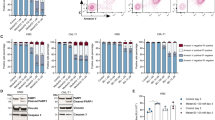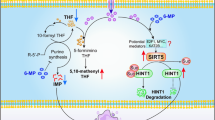Abstract
The oxidative pentose phosphate pathway (PPP) is crucial for cancer cell metabolism and tumor growth. We recently reported that targeting a key oxidative PPP enzyme, 6-phosphogluconate dehydrogenase (6PGD), using our novel small-molecule 6PGD inhibitors Physcion and its derivative S3, shows anticancer effects. Notably, humans with genetic deficiency of either 6PGD or another oxidative PPP enzyme, glucose-6-phosphate dehydrogenase, exhibit non-immune hemolytic anemia upon exposure to aspirin and various antimalarial drugs. Inspired by these clinical observations, we examined the anticancer potential of combined treatment with 6PGD inhibitors and antimalarial drugs. We found that stable knockdown of 6PGD sensitizes leukemia cells to antimalarial agent dihydroartemisinin (DHA). Combined treatment with DHA and Physcion activates AMP-activated protein kinase, leading to synergistic inhibition of human leukemia cell viability. Moreover, our combined therapy synergistically attenuates tumor growth in xenograft nude mice injected with human K562 leukemia cells and cell viability of primary leukemia cells from human patients, but shows minimal toxicity to normal hematopoietic cells in mice as well as red blood cells and mononucleocytes from healthy human donors. Our findings reveal the potential for combined therapy using optimized doses of Physcion and DHA as a novel antileukemia treatment without inducing hemolysis.
This is a preview of subscription content, access via your institution
Access options
Subscribe to this journal
Receive 50 print issues and online access
$259.00 per year
only $5.18 per issue
Buy this article
- Purchase on Springer Link
- Instant access to full article PDF
Prices may be subject to local taxes which are calculated during checkout







Similar content being viewed by others
References
Schafer ZT, Grassian AR, Song L, Jiang Z, Gerhart-Hines Z, Irie HY et al. Antioxidant and oncogene rescue of metabolic defects caused by loss of matrix attachment. Nature 2009; 461: 109–113.
Lin R, Elf S, Shan C, Kang HB, Ji Q, Zhou L et al. 6-Phosphogluconate dehydrogenase links oxidative PPP, lipogenesis and tumour growth by inhibiting LKB1-AMPK signalling. Nat Cell Biol 2015; 17: 1484–1496.
Beutler E . G6PD deficiency. Blood 1994; 84: 3613–3636.
Vives Corrons JL, Colomer D, Pujades A, Rovira A, Aymerich M, Merino A et al. Congenital 6-phosphogluconate dehydrogenase (6PGD) deficiency associated with chronic hemolytic anemia in a Spanish family. Am J Hematol 1996; 53: 221–227.
Caprari P, Caforio MP, Cianciulli P, Maffi D, Pasquino MT, Tarzia A et al. 6-Phosphogluconate dehydrogenase deficiency in an Italian family. Ann Hematol 2001; 80: 41–44.
Wang SJ, Sun B, Cheng ZX, Zhou HX, Gao Y, Kong R et al. Dihydroartemisinin inhibits angiogenesis in pancreatic cancer by targeting the NF-kappaB pathway. Cancer Chemother Pharmacol 2011; 68: 1421–1430.
Di JM, Pang J, Sun QP, Zhang Y, Fang YQ, Liu XP et al. Toll-like receptor 9 agonists up-regulates the expression of cyclooxygenase-2 via activation of NF-kappaB in prostate cancer cells. Mol Biol Rep 2010; 37: 1849–1855.
Fogarty S, Hardie DG . Development of protein kinase activators: AMPK as a target in metabolic disorders and cancer. Biochim Biophys Acta 2010; 1804: 581–591.
Hadad S, Appleyard V, Murray K, Baker L, Huang X, Alessi DR et al. A-769662 is an AMP kinase-dependant growth inhibitor in breast cancer cell lines. 2008 ASCO Breast Cancer Symposium 2008; Abstract No: 170.
Din FV, Valanciute A, Houde VP, Zibrova D, Green KA, Sakamoto K et al. Aspirin inhibits mTOR signaling, activates AMP-activated protein kinase, and induces autophagy in colorectal cancer cells. Gastroenterology 2012; 142: 1504–1515.e3.
Spears LD, Qin C, Zhang Z, Ralston L, Fisher JS . The ATM activator chloroquine stimulates phosphorylation of AMP activated protein kinase (AMPK) and acetyl CoA-carboxylase (ACC) independent of ATM. FASEB J 2010; 24 (Meeting Abstract Supplement): lb674.
Ha J, Daniel S, Broyles SS, Kim KH . Critical phosphorylation sites for acetyl-CoA carboxylase activity. J Biol Chem. 1994; 269: 22162–22168.
Hadad SM, Hardie DG, Appleyard V, Thompson AM . Effects of metformin on breast cancer cell proliferation, the AMPK pathway and the cell cycle. Clin Transl Oncol 2014; 16: 746–752.
Choudhury Y, Yang Z, Ahmad I, Nixon C, Salt IP, Leung HY . AMP-activated protein kinase (AMPK) as a potential therapeutic target independent of PI3K/Akt signaling in prostate cancer. Oncoscience 2014; 1: 446–456.
Chakrabarti KR, Whipple RA, Boggs AE, Hessler LK, Bhandary L, Vitolo MI et al. Pharmacologic regulation of AMPK in breast cancer affects cytoskeletal properties involved with microtentacle formation and re-attachment. Oncotarget 2015; 6: 36292–36307.
Acknowledgements
We thank the Hematology Division Tissue Bank, Winship Cancer Institute of Emory for providing primary tissue samples from leukemia patients. This work was supported in part by NIH grants CA140515, CA183594, CA174786 (to JC), the Pharmacological Sciences Training Grant T32 GM008602 (to SE), DoD grant W81XWH-12-1-0217 (to JC). SE is an NIH pre-doctoral fellow and an ARCS Foundation Scholar. JC is WCI 5K Scholar, Georgia Cancer Coalition Distinguished Scholar, American Cancer Society Basic Research Scholar and Scholar of the Leukemia and Lymphoma Society.
Author information
Authors and Affiliations
Corresponding author
Ethics declarations
Competing interests
The authors declare no conflict of interest.
Additional information
Supplementary Information accompanies this paper on the Oncogene website
Supplementary information
Rights and permissions
About this article
Cite this article
Elf, S., Lin, R., Xia, S. et al. Targeting 6-phosphogluconate dehydrogenase in the oxidative PPP sensitizes leukemia cells to antimalarial agent dihydroartemisinin. Oncogene 36, 254–262 (2017). https://doi.org/10.1038/onc.2016.196
Received:
Revised:
Accepted:
Published:
Issue Date:
DOI: https://doi.org/10.1038/onc.2016.196
This article is cited by
-
Artemisinin-type drugs for the treatment of hematological malignancies
Cancer Chemotherapy and Pharmacology (2021)
-
NADPH homeostasis in cancer: functions, mechanisms and therapeutic implications
Signal Transduction and Targeted Therapy (2020)
-
Physcion Enhances Sensitivity of Pancreatic Adenocarcinoma and Lung Carcinoma Cell Lines to Cisplatin
BioNanoScience (2020)
-
Exploiting metabolic vulnerabilities for personalized therapy in acute myeloid leukemia
BMC Biology (2019)
-
Inhibiting 6-phosphogluconate dehydrogenase enhances chemotherapy efficacy in cervical cancer via AMPK-independent inhibition of RhoA and Rac1
Clinical and Translational Oncology (2019)



